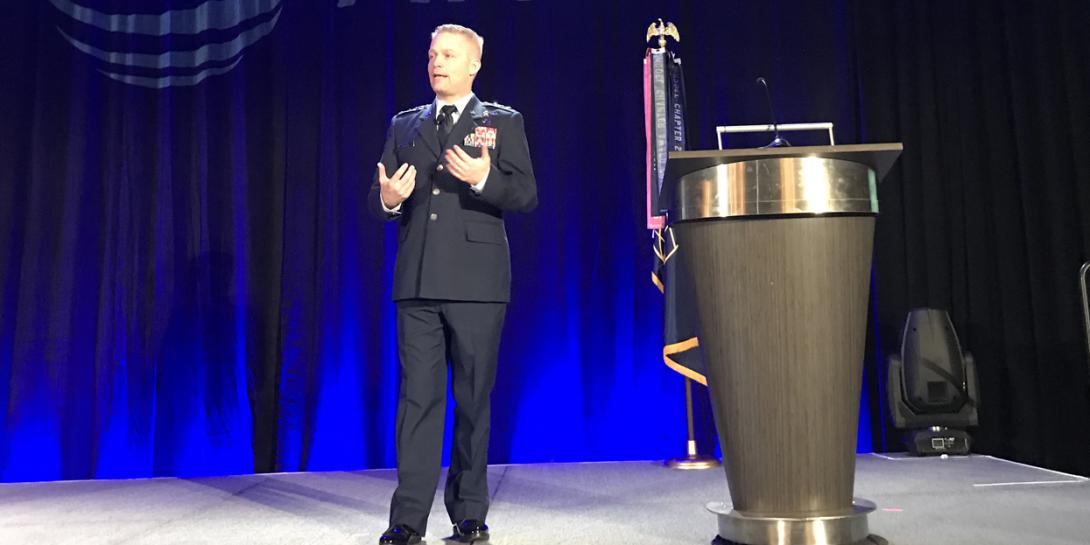The 16th Air Force Targets Capability Integration
Less than two months on the job, Lt. Gen. Timothy Haugh, USAF, commander of the 16th Air Force (Air Forces Cyber), is already shaping the structure of the service’s new information warfare Numbered Air Force (NAF). Stood up in October, the NAF combines the service’s cyber operations; intelligence, surveillance and reconnaissance (ISR) capabilities; electronic warfare and information operations, including capabilities folded in from the 24th and 25th Air Forces.
The commander’s immediate focus is the integration of these capabilities, Gen. Haugh told the audience at AFCEA Alamo’s 2019 ACE event in San Antonio on November 19. “Our fundamental challenge is how do we integrate those together to produce a more capable force that also is producing outcomes at the scale and the pace that our nation needs,” the general indicated.
The 16th Air Force also is charged with bringing back information operations capabilities into the service, growing the related information operations career field for airmen, called the 14F career field, and “integrating them in a manner that allows us to produce new outcomes that were not possible previously,” Gen. Haugh said.
The new NAF, located at Joint Base San Antonio-Lackland (JBSA-L), is already making progress in these aspects, the commander stated. “We're already seeing, in our first month of existence, opportunities by connecting elements across our enterprise that are working similar problems and can now be more effective by operating together,” he said. “And we don't need to do any additional organizational change to do that, we just need to allow people to step out and take action.”
Gen. Haugh reports to both Gen. Mike Holmes, USAF, commander of the Air Combat Command and, as the Air Force’s representative to the U.S. Cyber Command, to Gen. Paul Nakasone, USA, the commander of U.S. Cyber Command. As such, he will direct the NAF’s information warfare contribution across four main fundamental mission areas: globally integrated ISR, warfighter communications, global targeting and global weather.
Also, as the lead to the Joint Force Headquarters Cyber Air Force, Haugh will organize the information warfare support to several of the Combatant Commands, including the U.S. European Command, U.S. Transportation Command and U.S. Strategic Command. Being the service’s cryptologic component, the NAF will support airmen the service provides to the National Security Agency or to other efforts across the intelligence community.
The 16th Air Force includes 10 wings, including the 557th Weather Wing that came over from the 12th Air Force and provides key weather intelligence to the U.S. military, the federal government and allies. General Haugh does not foresee the need to alter the priorities of any of the wings.
“My expectation and my guidance to every wing commander is that I do not right now have any interest in changing the mission of any wing,” he said. “I want the individual wings to be great.”
However, the NAF will be merging its two operations centers together, the commander noted. “Today we have two operations centers focused on cyber and ISR, the 6-24th and the 6-25th,” he said. “We will consolidate those two into a single operation center in March and that will be our center for anything that occurs for an integration, or for command and control. That's where it will come together.”
The other big step that NAF will take in the next two months is to bring over the service’s part of the Joint Worldwide Intelligence Communications System (JWICS), the top secret/sensitive compartmented information network. “JWICS, which was operated inside our ISR enterprise, will move over and be operated by the 688th Cyber Space Wing, so that all of the networks in the Air Force will be run underneath a single wing, so that we can now leverage some of the tradecraft,” Gen. Haugh stated.
Additionally, the 16th Air Force is pursuing a streamlining effort of its defensive cyber tools as part of its so-called 12N12 effort, led by the 688th Cyberspace Wing. “What we've found is, as we've grown our cyberspace defense capabilities, in some cases we have gotten really over-enamored with the technology, and we've ended up with too many tools,” he explained. “And instead of allowing them to be absolute masters of the craft in a series of smaller subset of tools, we've now expanded that too far. So, the team is looking to reduce that, to be focused on 12 tools within 12 months [by July 2020].”
Gen. Haugh also expects to aid discussions around Joint All Domain Command and Control, or JADC2. “We will be the engine for much of that data that is going to inform [that],” he stated.




Comments